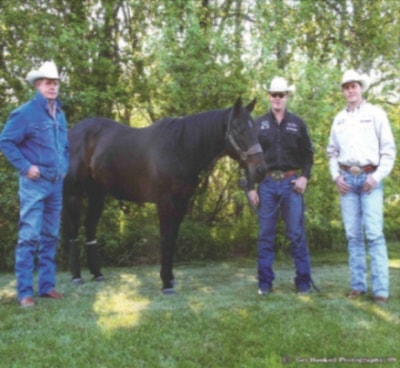Brian McLoughlin / Contributing writer
While there have been many family acts in the sport of rodeo, few if any equal the records set by Donalda’s Greg Cassidy and his sons Curtis and Cody. Between the three men, they own eight Canadian Finals Rodeo Steer Wrestling championships, six High Points championships, three Calgary Stampede Steer Wrestling championships and a Tie-down Roping championship, as well as a CFR Tie-Down Roping championship by Curtis Cassidy in 2001. In addition to that, they have won championship buckles, bronzes and other awards from rodeos all over the North America. And so far in 2011, Curtis Cassidy is the Canadian Professional Rodeo Association’s steer wrestling money and points leader, having garnered more than $26,000 through the middle of July.
Family is very important to the Cassidys and being able to compete together has been a highlight of the three men’s careers. “Being at the CFR (Canadian Finals Rodeo) and competing and winning with Curtis and Cody has been an unbelievable experience”, said Greg Cassidy. “Add in the Calgary and Ponoka stampedes, as well as the hundreds of other rodeos in between, and it has been an amazing ride”.
Each summer, the Cassidys travel thousands of miles competing in rodeos all over western Canada and the United States. In doing so, they and others in the rodeo family are continuing a tradition that started almost 200 years ago. The beginnings of rodeo can be traced back to the ranches of early California, Arizona, Texas and New Mexico. These early Spanish cattlemen, known as vaqueros, would influence the American cowboy with their clothing, language, traditions and equipment, which would in turn influence the modern sport of rodeo. Duties on these early ranches included roping, horse breaking, riding, herding and branding.
The early 1800s saw the westward expansion of the American border, with the philosophy of Manifest Destiny as the prevalent government policy. American newcomers from the East came into contact with Spanish, Mexican, Californio, and Texican cowboys and began to copy and adapt their styles and traditions of working the ranches.
In the mid to late 1800s, cattle from the West fed the massive population in the Eastern U.S., and the cattle business boomed, especially after the Civil War. To deliver cattle to eastern markets, ranchers from the West would drive massive cow herds hundreds of miles from ranches to the railhead.
At the end of the long trails, cowboys would often hold informal competitions amongst themselves and the various different ranch outfits to see which group had the best riders, ropers and all-around best hands. From those competitions, modern rodeo would eventually be born. The first recorded rodeos happened at that time.
Toward the end of the century, this open range era would come to an end with the expansion of the railroads and the introduction of barbed wire. There was no longer a need for long cattle drives, and rangelands were being divided amongst the increasing population of homesteaders and settlers. With the disappearing lifestyle of the western frontier, the popularity of rodeo grew, and rodeos began to spread all across the country. Cowboys, who had been facing grim job prospects, could now travel and make a living by rodeo alone. This was the birth of the professional rodeo competitor. Professional rodeos today generally comprise six different events: steer wrestling, tie-down roping, saddle and bareback bronc riding, bull riding and barrel racing.
Rodeo in Canada developed as cowboys from the northern U.S. brought herds up from Montana to establish some of the earliest cattle ranches in southern Alberta. They joined with Alberta ranch hands and immigrants from eastern Canada and the British Isles to produce today’s distinctive Alberta cowboy.
Organized rodeos began in Canada with Alberta’s Raymond Stampede in 1902 and hit the big time with the inaugural Calgary Stampede in 1912. Rodeo remains immensely popular in Alberta, with dozens of rodeos held each summer. This weekend’s Stettler Steel Wheel Stampede is one of the newest.
Today’s rodeo competitors are some of the most gifted athletes in sports today and that doesn’t just apply to the cowboys and cowgirls vying for the cash prizes.
Two of the best athletes over the last few years in pro rodeo are also members of the Cassidy family. Willy, a half quarter horse, half thoroughbred gelding and six time steer wrestling horse of the year, has been working with the Cassidys for almost 20 years and has helped them and a lot of other cowboys win more than $3 million in prize money.
Although Willy is still ready to answer the call, his protégé, Deuce, has also shown great promise and is now being worked into the family’s steer wrestling program. Honouring the past, working in the present and looking to the future, the Cassidys are very much a part of Canada’s rodeo heritage.
